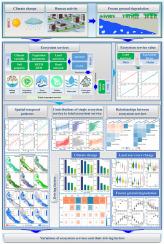IF 7
1区 经济学
Q1 DEVELOPMENT STUDIES
引用次数: 0
摘要
近几十年来,这些生态系统服务受到气候变化、人类活动和冻土退化的深刻影响。然而,迄今为止,有关QTP的相关研究仍然缺乏。为了弥补这一空白,我们选择了舒勒河上游,这是QTP中典型的以冰冻圈为主的盆地。采用InVEST、CASA和Noah-MP陆地表面模型,结合遥感和野外调查数据,评估了生态系统服务的时空格局和驱动因素,包括生境质量(HQ)、净初级生产力(NPP)、水资源涵养(WC)、碳储量(CS)、水量(WY)、绿地消闲(GSR)和总生态系统服务(TES)。结果表明:①2001 ~ 2020年,高寒、NPP、WC、CS、WY和GSR分别以0.004 a−1、1.920 g C·m−2·a−1、0.709 mm·a−1、0.237 Mg·ha−1、0.212 × 108 m3·a−1和0.038 × 109 km2·a−1的速率显著增加(P < 0.05);(2)暖湿气候和贫瘠面积的减少共同促进了HQ、NPP、WC、CS、WY和GSR的增加;(3)冻土退化对HQ、NPP、CS、GSR和TES有促进作用,对WY和WC有抑制作用(P < 0.05);(4)生态系统服务间协同效应显著;(5) 2001 ~ 2020年生态系统总服务价值以1.18 × 109 CNY·a−1的速率显著增加(P < 0.05),主要是供给服务价值增加所致。本文章由计算机程序翻译,如有差异,请以英文原文为准。

Variations and drivers of ecosystem services in the frozen ground regions of the Qinghai-Tibet Plateau
The alpine ecosystems of the Qinghai-Tibet Plateau (QTP) provide multiple ecosystem services. In recent decades, these ecosystem services have been profoundly affected by climate change, human activity, and frozen ground degradation. However, related research remains lacking to date in the QTP. To address this gap, the upper reaches of the Shule River, a typical cryospheric-dominated basin in the QTP, was selected. We simultaneously assessed the spatial-temporal patterns and driving factors of ecosystem services, including habitat quality (HQ), net primary productivity (NPP), water conservation (WC), carbon storage (CS), water yield (WY), green space recreation (GSR), and total ecosystem service (TES), by employing the InVEST, CASA, and Noah-MP land surface models in combination with remote sensing and field survey data. Our results showed that: (1) HQ, NPP, WC, CS, WY, and GSR all increased significantly from 2001 to 2020 at rates of 0.004 a−1, 1.920 g C·m−2·a−1, 0.709 mm·a−1, 0.237 Mg⋅ha−1·a−1, 0.212 × 108 m3·a−1, and 0.038 × 109 km2·a−1 (P < 0.05), respectively; (2) warm and humid climates, combined with shrinking of barren, contributed to the increases in HQ, NPP, WC, CS, WY, and GSR; (3) frozen ground degradation had promoting effects on HQ, NPP, CS, GSR, and TES, while inhibiting effects were observed on WY and WC (P < 0.05); (4) synergies among ecosystem services were prominent over the past 20 years; (5) the total ecosystem service value increased significantly at a rate of 1.18 × 109 CNY·a−1 from 2001 to 2020 (P < 0.05), primarily due to the increase in the provisioning service value.
求助全文
通过发布文献求助,成功后即可免费获取论文全文。
去求助
来源期刊

Habitat International
Multiple-
CiteScore
10.50
自引率
10.30%
发文量
151
审稿时长
38 days
期刊介绍:
Habitat International is dedicated to the study of urban and rural human settlements: their planning, design, production and management. Its main focus is on urbanisation in its broadest sense in the developing world. However, increasingly the interrelationships and linkages between cities and towns in the developing and developed worlds are becoming apparent and solutions to the problems that result are urgently required. The economic, social, technological and political systems of the world are intertwined and changes in one region almost always affect other regions.
 求助内容:
求助内容: 应助结果提醒方式:
应助结果提醒方式:


